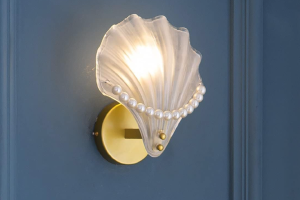Embracing Wabi-Sabi: Plaster Textured Wall Lamp
6 min readWabi-sabi is a Japanese aesthetic philosophy that finds beauty in the imperfect, the transient, and the incomplete. Rooted in Zen Buddhism, it emphasizes the acceptance of transience and the natural cycle of growth and decay. The term “wabi” originally referred to the simplicity and rusticity found in nature, while “sabi” denotes the beauty that comes with age and wear.
Together, they create a worldview that appreciates the fleeting nature of life and the unique character that imperfections bring to objects and experiences. This philosophy encourages individuals to embrace the natural world, recognizing that nothing is permanent and that beauty can be found in the most unexpected places. In a world increasingly dominated by mass production and perfectionism, wabi-sabi offers a refreshing counterpoint.
It invites us to slow down and appreciate the subtleties of our surroundings, fostering a deeper connection with the materials and objects we encounter daily. This perspective encourages mindfulness, urging us to find joy in simplicity and authenticity rather than striving for unattainable ideals. By understanding wabi-sabi, we can cultivate a more profound appreciation for the beauty that exists in our lives, even amidst chaos and imperfection.
The Beauty of Imperfection
The beauty of imperfection is a central tenet of wabi-sabi, manifesting in various forms across art, design, and everyday life. This concept challenges conventional notions of beauty that often prioritize symmetry, uniformity, and flawlessness. Instead, wabi-sabi celebrates asymmetry, irregularity, and the unique marks left by time and use.
For instance, a handmade ceramic bowl with an uneven rim or a slight crack tells a story of its creation and journey, inviting viewers to appreciate its individuality rather than dismissing it as flawed. In nature, imperfection is abundant and often breathtaking. The gnarled branches of an ancient tree, the weathered surface of a stone, or the delicate petals of a wilting flower all exemplify the beauty found in impermanence.
These elements remind us that life is not about achieving perfection but rather about embracing the journey and the experiences that shape us. By recognizing and valuing imperfection, we can cultivate a more profound sense of gratitude for the world around us, allowing us to find beauty in moments that might otherwise go unnoticed.
Embracing Wabi-Sabi in Home Decor
Incorporating wabi-sabi into home decor involves creating spaces that reflect authenticity, simplicity, and a connection to nature. This aesthetic encourages the use of natural materials such as wood, stone, clay, and textiles that exhibit texture and character. For example, reclaimed wood furniture with visible knots and imperfections can serve as a focal point in a room while simultaneously grounding it in a sense of history and craftsmanship.
The goal is to curate an environment that feels lived-in and welcoming rather than sterile or overly polished. Color palettes inspired by wabi-sabi tend to favor muted tones that evoke a sense of calm and tranquility. Earthy hues like soft browns, grays, and greens can create a soothing atmosphere that encourages relaxation and reflection.
Additionally, incorporating plants into your decor can enhance this aesthetic by bringing the outside in and reminding us of nature’s cyclical beauty. By embracing wabi-sabi principles in home decor, we can create spaces that not only reflect our personal style but also foster a sense of peace and connection to the world around us.
Plaster Textured Wall Lamp: A Wabi-Sabi Inspired Design
One striking example of wabi-sabi design is the plaster textured wall lamp, which embodies the principles of this aesthetic through its organic form and tactile surface. Crafted from natural materials like plaster or clay, these lamps often feature irregular shapes and textures that evoke a sense of authenticity and craftsmanship. The soft glow emitted by such lamps creates an inviting ambiance, enhancing the overall atmosphere of a room while highlighting the beauty of imperfection.
The design of a plaster textured wall lamp often reflects the natural world, with curves and contours reminiscent of organic forms found in nature. This connection to the environment reinforces the wabi-sabi philosophy by reminding us of our place within the larger tapestry of life. Furthermore, as these lamps age over time, they develop a unique patina that adds character and depth to their appearance.
This evolution mirrors the wabi-sabi belief in embracing change and finding beauty in the passage of time.
How to Incorporate Wabi-Sabi into Your Home with a Plaster Textured Wall Lamp
Incorporating a plaster textured wall lamp into your home decor can be an effective way to embrace wabi-sabi principles while enhancing your living space’s aesthetic appeal. Start by selecting a lamp that resonates with your personal style; look for one with an organic shape or an interesting texture that draws attention without overwhelming the room. Positioning the lamp strategically can create focal points within your space while also providing soft lighting that fosters relaxation.
To further enhance the wabi-sabi vibe in your home, consider pairing your plaster textured wall lamp with other elements that embody this philosophy. For instance, you might choose to display handmade pottery or textiles alongside the lamp to create a cohesive look that celebrates craftsmanship and individuality. Incorporating natural materials like wood or stone in your furniture choices can also complement the lamp’s aesthetic while reinforcing your commitment to authenticity and simplicity.
Creating a Serene and Tranquil Atmosphere with Wabi-Sabi Decor
Creating a serene and tranquil atmosphere through wabi-sabi decor involves curating spaces that promote mindfulness and reflection. Begin by decluttering your environment; remove items that do not serve a purpose or bring you joy. This process allows you to focus on the objects that truly resonate with you, fostering a sense of peace within your home.
Once you have streamlined your space, consider incorporating elements that evoke calmness—such as soft textiles, natural light, and earthy colors. In addition to physical elements, sound plays a crucial role in establishing tranquility within your home. Incorporating gentle sounds—like wind chimes or water features—can enhance the serene atmosphere created by your decor choices.
The goal is to create an environment where you can unwind and reconnect with yourself amidst life’s chaos. By embracing wabi-sabi principles in your decor choices, you can cultivate a sanctuary that nurtures your well-being and encourages introspection.
The Timeless Appeal of Wabi-Sabi in Interior Design
The timeless appeal of wabi-sabi in interior design lies in its ability to transcend trends while remaining relevant across generations. As society becomes increasingly aware of environmental issues and the importance of sustainability, wabi-sabi’s emphasis on natural materials and craftsmanship resonates more than ever. This aesthetic encourages individuals to invest in quality pieces that tell a story rather than succumbing to fast fashion or disposable design trends.
Moreover, wabi-sabi’s focus on authenticity allows for personal expression within interior design. Each individual’s interpretation of this philosophy can result in unique spaces that reflect their values and experiences. Whether through handmade items collected during travels or family heirlooms passed down through generations, wabi-sabi invites homeowners to curate environments filled with meaning rather than mere decoration.
This enduring quality ensures that wabi-sabi will continue to inspire designers and homeowners alike for years to come.
Embracing Simplicity and Authenticity with Wabi-Sabi Home Decor
Embracing simplicity and authenticity through wabi-sabi home decor involves prioritizing quality over quantity while fostering connections with both objects and nature. Begin by selecting pieces that resonate with you personally—items that evoke memories or emotions rather than those chosen solely for their aesthetic appeal. This approach encourages mindfulness in your purchasing decisions while creating an environment filled with meaning.
Additionally, consider incorporating handmade or artisanal items into your decor to further emphasize authenticity. These pieces often carry stories from their creators, adding depth to your space while supporting local artisans or sustainable practices. By embracing simplicity in both design choices and lifestyle habits—such as decluttering regularly—you can cultivate an environment that reflects your values while promoting tranquility within your home.
Ultimately, wabi-sabi invites us to celebrate life’s imperfections while finding joy in simplicity and authenticity.


